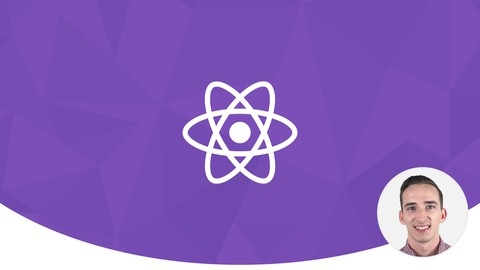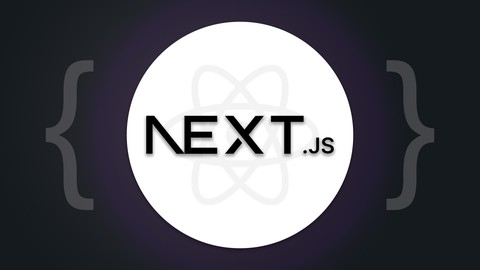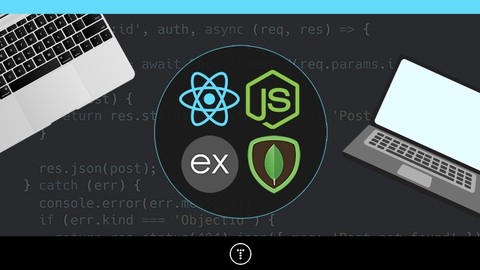React - The Complete Guide 2024 (incl. React Router & Redux)
This course starts by teaching you the fundamentals of React, including components, props, and state management.
You’ll learn how to build modern, reactive user interfaces and handle user events.
Once you have a solid grasp of the basics, the course dives into more advanced topics like styling React components and working with forms.
You’ll also explore the React Router library, which allows you to create multi-page applications with navigation.
The course then covers Redux, a popular state management library for React apps.
You’ll learn how to manage global state, handle asynchronous actions, and integrate Redux with React.
As you progress, you’ll build a complete project from scratch, solidifying your understanding of React and its ecosystem.
This hands-on approach ensures you gain practical experience and confidence in using React for real-world applications.
Throughout the course, you’ll work with modern JavaScript syntax and features, preparing you for the latest developments in the React world.
Additionally, you’ll learn how to deploy your React applications to a live URL, making them accessible to the world.
Modern React with Redux [2024 Update]
This comprehensive React course covers everything you need to build professional-grade applications using React and Redux.
It starts by laying a solid foundation, guiding you through JSX syntax, components, props, state management, and event handling.
You’ll learn how to convert HTML and CSS to JSX, work with forms, make API calls with Axios, and render dynamic lists.
The course then dives deep into React hooks like useState, useEffect, and custom hooks, enabling you to write more concise and reusable code.
You’ll build interactive components like accordions, dropdowns, and modals, mastering techniques like conditional rendering, refs, and portals.
As you progress, you’ll explore Redux, a popular state management library.
You’ll learn Redux fundamentals like actions, reducers, and the Redux store, integrating Redux with React using react-redux.
The course covers advanced Redux concepts like async actions with Redux Thunk, Redux Toolkit for reducing boilerplate, and managing normalized data.
The syllabus includes building real-world projects, such as a video player app that interacts with YouTube’s API, a streams app with CRUD functionality, and a Google Maps clone.
You’ll learn to handle authentication with OAuth, create reusable navigation systems, fetch data, and optimize performance.
Towards the end, you’ll learn Redux Toolkit Query for efficient data fetching and caching, followed by an introduction to TypeScript and its integration with React.
The course wraps up by building a full-fledged app that fetches data from an API, showcasing the power of React Router for client-side routing.
Throughout the course, the instructor emphasizes best practices, code organization, and project structure.
You’ll learn to create reusable and maintainable components, manage complex state, and optimize your React applications for performance.
The Complete React Native + Hooks Course
The course starts by getting you set up with the necessary tools like Node.js, React Native, and code editors.
You’ll learn how to create and run your first React Native app on iOS and Android simulators.
It then dives into the fundamentals of React components, JSX rules, building lists with FlatList, and navigating between screens using React Navigation.
You’ll build reusable components, manage state, handle user input, and style your app’s layout.
As you progress, you’ll build several real-world apps, including a restaurant search app that integrates with the Yelp API.
You’ll learn advanced state management using Context and the useReducer hook.
The course covers data fetching, creating custom hooks, and navigation with parameters.
It gets more advanced by teaching you to build a full-fledged backend with Express and MongoDB.
You’ll implement user authentication, JWT tokens, and connect your React Native app to this custom API.
Additionally, you’ll learn to track the user’s location and build features like recording fitness tracks.
The course is very hands-on, with exercises after each major concept.
You’ll gain experience upgrading apps to the latest React Navigation v6 library.
It covers useful techniques like avoiding stale component references and cleaning up effects.
While maintaining a conversational tone, the course incorporates all the necessary technical details you need to build professional React Native apps from scratch.
React Native - The Practical Guide [2024]
The course starts by introducing you to React Native and guiding you through setting up your development environment.
You’ll learn about the different project creation methods, including Expo CLI and React Native CLI, and how to run your first app on a real mobile device.
Next, you’ll dive into React Native basics by building a Course Goals app.
This hands-on project will teach you about core components, styling, layouts with Flexbox, handling events, managing lists with FlatList, and more.
You’ll also learn how to split components, work with props, and add modals.
The course then covers debugging techniques, including handling errors, console logging, remote debugging, and using React DevTools.
This is crucial for identifying and fixing issues during development.
Moving on, you’ll build a mini-game app to deepen your understanding of components, layouts, and styling.
You’ll work with custom buttons, number inputs, linear gradients, background images, and game logic.
This project also covers managing global colors, using icons and custom fonts, and displaying nested text.
To make your apps adaptive to different platforms and device sizes, you’ll learn about the Dimensions API, useWindowDimensions hook, and writing platform-specific code.
This section ensures your apps look great on various screen sizes and orientations.
Navigation is a vital aspect of any app, and the course covers React Navigation in depth.
You’ll build a Meals app, exploring stack navigation, drawer navigation, tabs, and nested navigators.
You’ll also learn about passing data between screens and setting dynamic navigation options.
App-wide state management is covered using both the Context API and Redux (with Redux Toolkit).
This will help you manage and share data across your app efficiently.
The course then guides you through building an Expense Tracker app, putting into practice everything you’ve learned so far.
This includes navigation, styling, managing expenses, handling user input with forms and validation, and using context for state management.
You’ll also learn how to send HTTP requests to backend APIs, handle responses, and update data.
The course covers user authentication, including signup, login, token management, and accessing protected resources.
Additionally, you’ll explore using native device features like the camera, location services, maps (Google Maps and Apple Maps), and SQLite databases by building a Places app.
For those interested in building React Native apps without Expo, the course has a dedicated section covering the bare workflow, ejecting from Expo, and using the React Native CLI.
The course wraps up by teaching you how to publish your apps to the app stores, configure app icons and splash screens, and implement push notifications.
Throughout the course, you’ll find quizzes, coding exercises, and detailed explanations to reinforce your learning.
The instructor’s clear and concise teaching style, along with the hands-on projects, make it easy to follow and understand the concepts.
Complete React Developer (w/ Redux, Hooks, GraphQL)
The course starts by covering React’s key concepts, including its declarative nature, component architecture, and one-way data flow.
You’ll learn how to set up a development environment and use Create React App to scaffold new projects.
The course dives deep into React basics, guiding you through building a Monsters Rolodex app using both class and functional components.
You’ll explore state management, lifecycle methods, hooks like useState and useEffect, and how React renders and re-renders components.
The instructor emphasizes understanding core concepts like pure functions and the virtual DOM.
As you progress, you’ll build a capstone e-commerce project from scratch, implementing routing, authentication with Firebase, context API, and Redux for state management.
The course covers advanced Redux topics like Redux-Thunk, Redux-Saga, and the Redux Toolkit.
You’ll also learn how to integrate Stripe for payments using serverless functions.
The syllabus covers TypeScript integration, typing Redux files, Firebase utils, and React components.
You’ll dive into GraphQL with Apollo Client, exploring queries, mutations, and caching.
Performance optimization techniques like code-splitting, React.memo, and useMemo are covered as well.
The instructor emphasizes best practices, such as writing tests with Jest and Enzyme/React Testing Library.
You’ll learn about Webpack and Babel, and even build a blog using Gatsby.js.
The course wraps up with advice on open-source contributions, coding challenges, and common React interview questions.
The Complete React Developer Course (w/ Hooks and Redux)
The course starts by setting up your development environment and introducing you to React’s core concepts, such as components, JSX, state management, and lifecycle methods.
You’ll learn how to work with third-party components and style your applications using tools like Webpack and SCSS.
As you progress, you’ll dive into more advanced topics like React Router for client-side routing, Redux for state management, and testing your React components with Jest and Enzyme.
The course also covers deploying your applications to platforms like Heroku and integrating with Firebase for authentication and real-time database functionality.
One notable aspect is the inclusion of modern features like React Hooks, which simplify state management and provide reusable logic across components.
The course covers the useState, useEffect, useReducer, and useContext hooks, along with creating custom hooks.
Throughout the course, you’ll build practical projects like a budget manager and a blog application, allowing you to apply the concepts you’ve learned.
The instructor, Andrew Mead, provides clear explanations and walks you through each step, ensuring you understand the material thoroughly.
Microservices with Node JS and React
The course starts by introducing the fundamental concepts of microservices and the challenges associated with data management and communication between services.
You’ll build a mini-microservices app from scratch, learning how to handle CORS errors, create services for posts and comments, and implement an event bus for asynchronous communication.
The course dives deep into using Docker and Kubernetes for containerization and orchestration, covering important concepts like pods, deployments, services, and ingress.
As you progress, you’ll learn about advanced topics such as response normalization strategies, database management with MongoDB, authentication strategies, and testing isolated microservices.
The course also covers server-side rendering with Next.js, code sharing between services, and implementing CRUD operations.
You’ll gain hands-on experience with NATS Streaming Server as an event bus implementation, handling concurrency issues, and building worker services for tasks like order expiration.
The course covers integrating payment systems like Stripe and implementing CI/CD workflows with GitHub Actions for automated testing and deployment.
Throughout the course, you’ll work on a real-world ticketing application, learning how to handle events, data replication, and integrating various microservices.
Next.js 14 & React - The Complete Guide
The course starts by introducing you to Next.js, explaining what it is and why it’s a great addition to React.js.
You’ll learn about its key features and benefits, such as server-side rendering, file-based routing, and the ability to build fullstack apps with ease.
After the introduction, you have the option to go through a React refresher module, which ensures that everyone is on the same page with React fundamentals like components, props, state, events, and routing.
From there, the course dives into the essentials of Next.js, covering the App Router, file-based routing, page rendering, React Server Components vs Client Components, data fetching, and server actions.
You’ll learn how to add routes, handle dynamic routes, and fetch data for pre-rendering pages.
The course then moves on to more advanced topics, such as optimizing Next.js apps, adding backend code with API routes (fullstack React), working with app-wide state using React Context, and building a complete blog app from scratch.
One of the highlights of the course is the project-based learning approach.
You’ll apply what you’ve learned by building real-world projects, such as an events app and a food delivery app.
These projects will help you solidify your understanding of Next.js and React concepts.
Towards the end, the course covers deploying Next.js apps, adding authentication (user sign-up, sign-in, logout, tokens, and route protection), and provides a concise summary of all the core Next.js features.
Throughout the course, you’ll work with modern technologies like MongoDB, SQLite, AWS S3, and learn best practices for building scalable and performant web applications.
The instructor’s clear and concise explanations, along with the provided code snapshots and resources, make it easy to follow along and reinforce your learning.
MERN Stack Front To Back: Full Stack React, Redux & Node.js
You’ll start by setting up a MongoDB database with Atlas and connecting it to a Node.js server using Express and Mongoose.
The course dives deep into building secure user authentication with JSON Web Tokens (JWT) and implementing API routes for user registration, login, and profile management.
You’ll learn how to validate requests, create models, and implement middleware for authentication.
Once the backend is set up, you’ll move on to the frontend, where you’ll build a React application with Redux for state management.
The course covers setting up React Router for navigation and creating components for user registration and login forms.
With Redux in place, you’ll integrate alerts and build out the user authentication flow, including loading the user, setting the auth token, and implementing logout functionality.
The course then guides you through creating a dashboard and profile management system, where users can create, edit, and delete their profiles, adding details like education and experience.
You’ll also learn how to display profiles, fetch data from the GitHub API, and address console warnings.
The course dedicates a section to building out post and comment functionality, covering actions like creating, liking, unliking, deleting posts and comments.
Towards the end, you’ll prepare your application for deployment and learn how to deploy it to Heroku using the Heroku CLI.
The course also covers additional topics like creating a not-found page and addressing theme-related issues.
Throughout the course, you’ll gain hands-on experience with the MERN stack, learning how to build a full-stack application from scratch.
The instructor provides project files and links to supplementary resources like a theme-building series on YouTube.
Node with React: Fullstack Web Development
The course starts by setting up the server-side architecture with Node and Express.
You’ll learn how to generate Express apps, handle routes, and deploy to platforms like Heroku and Render.
Authentication is implemented using Google OAuth, giving you hands-on experience with the OAuth flow and Passport.js.
MongoDB is then integrated as the database, covering everything from setting up Atlas to creating models and handling queries.
You’ll dive deep into authentication, encoding users, managing sessions, and logging in/out.
The focus then shifts to the client-side, where you’ll generate a React app and learn how to run it alongside the server.
Redux is introduced for state management, and you’ll build out components like the header and landing page.
Importantly, you’ll handle payments using Stripe’s API, allowing users to purchase credits.
As you progress, you’ll create surveys that can be emailed out, leveraging services like SendGrid (or Mailgun) for email delivery.
Webhooks are implemented to track user feedback, involving techniques like data parsing and processing pipelines.
The course culminates with fetching and displaying surveys, giving you a complete full-stack application.
Along the way, you’ll encounter real-world challenges like handling different environments (dev vs. prod), version control, and deployment strategies.


![Modern React with Redux [2024 Update]](/img/best-react-courses-udemy/705264_ModernReactwithRedux2024Update.jpg)

![React Native - The Practical Guide [2024]](/img/best-react-courses-udemy/1436092_ReactNative-ThePracticalGuide2024.jpg)





